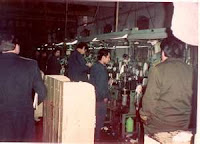This week inmates in Georgia organized a prison protest in four prisons through the use of cell phones which are considered contraband. While how they acquired the cell phones has been of interest to many (likely from Corrections Officers for approximately $400 a piece), what they were protesting brings into focus an issue that critics of the prison industrial complex have long criticized, the politics of prison labor.
More than 90% of inmates in the U.S. are working inside prisons, most of whom get paid from 9 to 25 cents a hour. Depending on the state, a portion of these earnings go to victim rights funds, court dues, child support, room and board fees.
According to Richard Davidson, Deputy Secretary of Florida Department of Corrections, on NPR's, "Inmates' Jobs from Call Centers to Paint Mixing," there are three types of prison work: work that help keep the prison running (laundry, custodial and kitchen work), prison industry work where the prison itself manages a business ( manufacturing furniture, printing press), and the newest development in
prison labor-private industries entering the facilities, setting up shop, and allegedly pay the going rate.
Callers to the broadcast different views of prison labor based on their own experiences in prison. One man referred to the work as "slave labor," recalling his experience of being woken up at 3:30am , getting strip searched, working, and returning to his dormitory to get only three hours of sleep. Often, he witnessed others beaten for the money they earned. He also reminded listeners that inmates have to pay for their necessities, so they wouldn't have soap or a toothbrush if they didn't work.
Another caller, who worked in a lower security federal prison spoke about his prison job, receiving food for the compound, recalled how the responsbility given to him and his freedom to interact with individuals outside the prison was essential for his rehablitation.
Davidson echoed the role of work as a rehabilitative intervention, "..The primary purposes of our programs is to reduce the recidivism rate. We have approximately 88 percent of the inmates who are in our
prisons leaving one day. Our general recidivism rate is 33 percent, but for inmates who go through our industries, that recidivism rate drops. . . to about 14%.
To hhear more formerly incarcerated individual's views on work in prison, as well as an employer who hires prisoners for her copy, click here for the broadcast.







.jpeg)

